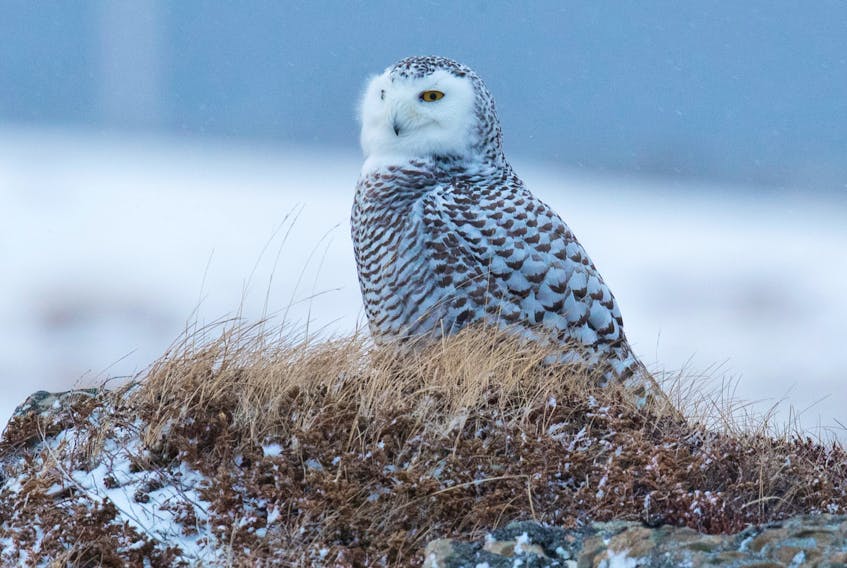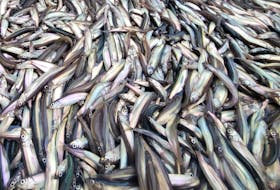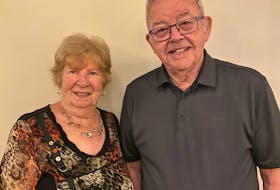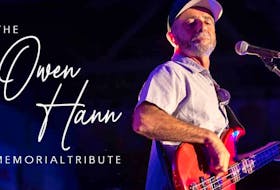Visiting birder Rick West photographed a gyrfalcon flying past Cape Spear. This report caused a stir among the St. John’s birders. A gyrfalcon is one of the most highly sought-after birds on the planet. It lives in the high Arctic and sometimes comes as far south as the Avalon Peninsula in the winter. It is the world’s biggest falcon. Everything about the bird is spectacular. Over the next days there were a couple of more brief sightings of the elusive gyrfalcon at Cape Spear.
We went to Bonavista to greet the ice as it reached Cape Bonavista. With gyrfalcons sightings already happening in the St. John’s area, Bonavista seemed like an excellent bet to look for more gyrfalcons and maybe even an ivory gull. We were going to go for the gold.
Gyrfalcons live on seabirds. They hunt along rocky coastlines but can also spend weeks at a time living out on the pack ice in search of seabirds. While the Avalon Peninsula has been enjoying a rather warm winter, Labrador and northern Newfoundland has been in the cold. The ice is forming well this year and moving south with the current and northwest winds at a pace likened to the winters of the 1990s.
When the ice pack reaches the Avalon Peninsula it can mean a number of exciting possibilities. For one thing it forces large numbers of eiders wintering on the northeast coast of Newfoundland to move farther south. Then there is the mythical ivory gull. They are out there on the outer edge of the ice pack, but this their comfort zone. It still requires a good storm to create a chance of seeing ivory gulls from land. Gyrfalcons are a realistic prize of big ice years. Birders who were active during the cold winters of the 1990s remember some amazing winters for seeing gyrfalcons. Those years have become legend after the growing trend of light ice years in the last decade or more.
According to the daily ice charts on the Environment Canada marine weather page the ice edge was set to reach Cape Bonavista this past weekend. This point of land sticking strategically north into the ocean has always intrigued us. We do not get there often enough at the right time because it is a little too far away for a day trip from St. John’s. So why not make a weekend out of it? That is exactly what John Wells, Ken Knowles and I did. We went to Bonavista to greet the ice as it reached Cape Bonavista. With gyrfalcons sightings already happening in the St. John’s area, Bonavista seemed like an excellent bet to look for more gyrfalcons and maybe even an ivory gull. We were going to go for the gold.
We departed town a couple hours before daylight on a snowy Saturday. After brief stops to check out the geese and ducks at Clarenville and enjoy a chance encounter with a big flock of bohemian waxwings at Bloomfield, we arrived at Bonavista.
We drove straight out to the Cape Bonavista lighthouse. The ice edge was barely discernable in the distance. The southwest wind overnight had pushed it back offshore. We set up our spotting scopes under the lighthouse and looked out to sea. There were just a few common eiders, long-tailed ducks and black guillemots to see on the water. Even gulls flying by were scarce. A snowy owl was sleeping on the icy side of a small island. Often your dreams exceed reality. That was okay. Birding is always a gamble. Without the dreams you would spend more wintry weekends indoors at home.
After couple hours of we went back into Bonavista town and checked into our cabin retreat with the nice view of the ocean. Not surprisingly we were the only people staying there in mid-winter. We regrouped and headed back out to the lighthouse for an afternoon watch.
Often your dreams exceed reality. That was okay. Birding is always a gamble. Without the dreams you would spend more wintry weekends indoors at home.
Throughout the afternoon the snow stopped. The evening light over the snowy coast was enchanting in the calm winter air. Looking back over the land from the lighthouse we started picking out snowy owls sitting on hill tops. They were getting active before sunset and flying in out of the country and perching on bald hilltops. It was their magic hour. They were fully awake now with eyes wide open and heads swiveling around surveying their surroundings. We counted 13 of the magnificent owls. What was on their minds? Were they planning on flying out to the ice to hunt seabirds under the cover of darkness?
Overnight the wind came up to a strong northerly gale. There was not a snowy owl to be seen at dawn. The ice was moving quickly back into shore. We put in three hours of sea watching hoping snag a gyrfalcon riding the updrafts along the cliffs or out by the islands. It did not happen. It was time to drive home.
We went to Bonavista with hopes of gold. You improve your chances of reaching lofty goals with the knowledge gained from the practice. Birding in the winter scene of rugged Cape Bonavista as it came alive with snowy owls on the Saturday evening was good enough for a solid bronze place finish. It was a worthwhile weekend getaway.
Bruce Mactavish is an environmental consultant and avid birdwatcher. He can be reached at [email protected]









